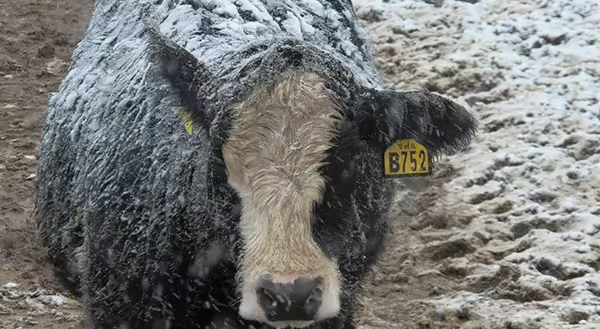
As livestock owners care for livestock in frigid temperatures, it is important to know where efforts are best spent. Cattle handle cold weather quite well as long as they have a dry, heavy winter hair coat.
Strategies to help cattle in cold weather
- Provide windbreak or shelter. A heavy winter haircoat is the cow's best defense to the cold. If that haircoat gets wet or is subject to wind, it is less effective. Thus, keeping cows dry and out of the wind drastically improves their ability to handle cold weather.
- Provide bedding. Giving cattle some additional insulation from the cold ground can help. A heavily bedded area can also serve as a place for cows to nest and get out of the cold.
- Provide enough windbreak or bedding for all. In situations where calves are present make sure there is plenty of room in these areas. If cows are huddling or crowded, the possibility of calves getting stepped on increases.
- Make sure water is available. Keeping waters thawed is important. Cows will actually drink more water when experiencing cold stress. Normally, assume cows will drink 1 gallon per 100lbs. However, when stressed they tend to consume closer to 2 gallons per 100lbs.
- Provide additional energy in the diet. Cows can utilize body fat reserves for energy. However, in an effort to keep cows from becoming thin over periods of cold weather or environmental conditions that increase maintenance requirements, providing additional energy in the diet is suggested. This can be accomplished by providing higher quality forages, supplemental grains or co-product feeds.
- Feed in the afternoon or early evening. The digestive process of a ruminant animal generates heat. Thus, feeding later in the day can allow for this digestive heat to help warm the animal in the overnight period when temperatures will be the coldest.
As always remember that livestock are hardy critters and with a little help can easily make it through short periods of cold stress. When cold and bitter temperatures are sustained for long periods, special attention to the above strategies will be needed.
Livestock producers worry about livestock before themselves on most all days. But it is important in extreme weather to have a strategy to keep yourself warm and fueled. A few tips for farmers as they need to take precautions when tending to animals in cold temperatures:
- Dress in layers, insulate yourself with plenty of clothing. Hat, scarf, gloves are a must
- Wear waterproof exterior layers. Change into dry clothing if clothes become wet or saturated
- Have a change of clothes, extra hat, extra gloves in the truck or tractor
- Keep your feet and hands dry
- Bring hand or foot warmers
- Keep your phone charged or a charger close. You may need to call in reinforcements.
- Keep tractors, trucks, and equipment full of fuel in case you get stuck or stranded. This will ensure the equipment can run and keep warm until help arrives.
- Don't be afraid to go inside to warm up